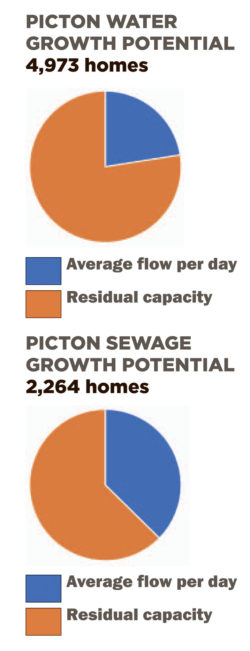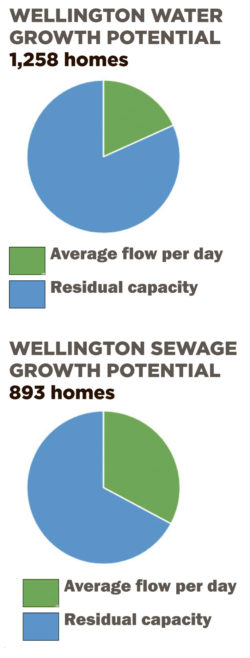County News
Room to grow

 Waterworks utility is an underused asset
Waterworks utility is an underused asset
There is no shortage of capacity to grow in the County—no obvious structural constraint anchoring residential development. So why does the County continue to lag Quinte West and Belleville in the race to grow our tax bases?
New home building jumped nicely in the last quarter of 2016, pushing new home starts to their highest level since 2009. However, 128 new homes is still well shy of the residential building pace set in Belleville and Quinte West— where 156 (to November 31) and 210 new single detached homes were built in 2016.
The constraint isn’t the County’s waterworks system. There is plenty of capacity in the system— particularly in Picton and Wellington.
According to calculations prepared by the Engineering, Works and Development department for the ad hoc committee looking at waterworks rates in the County, the existing plants in Picton and Wellington have the capacity to add 3,157 homes without adding another pump or filter.
Assuming an annual tax bill of $2,200, if fully built out this dormant capacity could producing $7 million more each and every year for County coffers. Money that could be used to fix roads, plant trees, improve parks and enhance services—things municipalities are supposed to do.
The committee is currently working toward a broad set of recommendations everyone hopes will guide the waterworks system to financial solvency and put in place the resources to fund the repairs and major upgrades needed over the next couple of decades. But to do so likely means higher water bills for the foreseeable future.
Getting there has meant a closer look at spending plans. This began with a reassessment of growth prospects and track record of the six water systems (plants and pipes) and two wastewater treatment system that comprise the County eclectic waterworks utility.
A critical guiding principle was establishing the five-year rolling average as the lens through which growth should be measured and projections calculated for the purposes of assessing capital expenditure needs and timing. This simply means using an average of the last five years, but on a rolling basis. That is, when the measurement of the current year is tallied, the oldest year drops out of the average. In this way, the average remains current, representative of the trend and avoids over reaction to a blip that may occur in any single year.
 This was an important decision because it provides the basis for the County’s works department to slow down spending and thus mitigate the impact on current ratepayers—most of whom are likely unwilling to fund the addition of capacity for growth that may not arrive.
This was an important decision because it provides the basis for the County’s works department to slow down spending and thus mitigate the impact on current ratepayers—most of whom are likely unwilling to fund the addition of capacity for growth that may not arrive.
County works chief Robert McAuley cautions however that this approach runs the risk that the County is unable to keep up with development pressures, should they arise, because the lag time on certain waterworks projects can be longer than the five-year measurement tool.
“For example, it can take longer than five years to bring expanded treatment plant or collection or distribution capacity to market,” wrote McAuley in memo to the committee. “As a result, the infrastructure needed for growth may not be available when development requests it.”
To offset this risk, McAuley recommends that the County adopt an 80- per-cent-full trigger to begin system expansion. That is, when the waterworks system nears the upper limits of its capacity, the five-year rolling average method should be set aside in favour of a more vigorous approach.
In any event, the exercise has armed residents, committee members and council with a vast new bank of data to consider as the County continues to learn the waterworks business. It is a resource that would be a shame to allow to slip away untended till the next crisis comes along.



Comments (0)